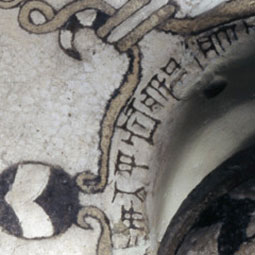Writing cuneiform on other media
Cuneiform TT was usually written on clay, but it was also recorded on stone, metal, wax-filled wooden writing boards, and could even be inked onto clay. The Aramaic TT alphabet was also used sometimes alongside or instead of cuneiform, inked on or scratched into clay. These materials and techniques were used to create different types of texts, from royal inscriptions and scholarly texts to letters and legal documents. Each type of text had its own characteristics.

Image 1: Lapis lazuli TT mace-head dedicated by king Assurnasirpal II to the god Ea PGP (1) but found by Layard in Ninurta's temple in Nimrud. BM 91452. View large image on British Museum website. © The Trustees of the British Museum.
Monuments
Stone and metal were more resilient against damage than clay, and also more expensive. They were used particularly for votive TT or monumental inscriptions.
Palace walls were covered in reliefs TT with magical functions or illustrating victorious campaigns. Cuneiform texts could be carved around, or over, them in large letters. The Standard Inscription of Assurnasirpal II is a good example. Sometimes the scenes would be labelled with a caption, spelling out the name of the city being captured, for example. It seems likely that a scribe TT first drew the outline of the cuneiform signs in ink, and a stonecutter then carved them out. The deeds and prayers of the king could also be inscribed on statues and monuments like the Black Obelisk.
Portable objects

Image 2: A metal weight in the shape of a lion, from a set of sixteen found by Layard. It is inscribed in both Akkadian TT cuneiform ("Palace of Shalmaneser, king of Assyria, 2 royal minas TT ") and Aramaic alphabet TT ("2 royal minas"). BM 91222. View large image on British Museum website © The Trustees of the British Museum.
A wide range of other artefacts were inscribed with text, such as votive TT objects, weights and amulets TT . Weights were made from metal, often in the shape of a crouching lion, which was a symbol of kingship in Assyria (Image 2). Weights could be labelled in Akkadian TT cuneiform or the Aramaic alphabet. Another traditional weight form, dating back many centuries, was a duck carved from stone.
Writing boards
From around the late 3rd millenium BC onwards, scribes sometimes wrote cuneiform on writing boards TT . Wooden or ivory TT boards were filled with a layer of softened wax, which could then be inscribed in the same way as a clay tablet TT . Two or more leaves were bound and folded together, protecting the inscription inside. Remarkably, a few boards survive today. They had been thrown down a well, perhaps during the destruction of Kalhu in 612 BC. Cuneiform texts on clay tablets tell us that boards were once common.

Image 3: Detail of a carved stone relief from Nineveh showing a scribe counting war booty using a writing board (right). BM 124955. View large image on British Museum website. © The Trustees of the British Museum.
Writing boards were used for both administrative and scholarly purposes. Assyrian palace reliefs TT show them in use on campaign (Image 3). Scribes are shown in pairs, one writing in cuneiform on a board or a tablet, the other writing in Aramaic on a leather scroll. Tablet making was a skilled task. The logistics of sourcing, producing and maintaining a tablet whilst away from the facilities of the workplace may have proved more awkward than using a writing board.
Writing cuneiform in ink

Image 4: A glazed TT wall plaque TT from the temple of Ištar, mistress of the Kidmuru at Nimrud. BM 91680. View large image on British Museum website. © The Trustees of the British Museum.
Cuneiform could occasionally be written in ink, paint, or glaze although it is not well suited to this technique. To form a wedge TT in clay takes a single stroke; writing one in a liquid medium takes three strokes, drawing the three sides of the triangular outline.
At Nimrud cuneiform inscriptions are found on wall plaques TT that decorated the temple of Ištar, mistress of the Kidmuru. They were glazed with multicoloured designs and a short inscription (Images 4, 5).

Ink had long been used by cuneiform scribes for various purposes. Scribes working in the royal city of Nineveh in the 7th century sometimes wrote the colophons TT to library tablets in ink. It was much more commonly used for writing Aramaic.
Content last modified: 18 Dec 2019
References
- Grayson, A.K., 1996. Assyrian Rulers of the Early First Millennium BC II (858-745 BC) (Royal Inscriptions of Mesopotamia. Assyrian Periods. Volume 3), Toronto: University of Toronto Press, pp. 353-4, A.101.100. (Find in text ^)
Further reading
- Wiseman, D. J., 1955. "Assyrian writing-boards", Iraq 17, pp. 3-13 (PDF available via JSTOR for subscribers).
Jonathan Taylor
Jonathan Taylor, 'Writing cuneiform on other media', Nimrud: Materialities of Assyrian Knowledge Production, The Nimrud Project at Oracc.org, 2019 [http://oracc.museum.upenn.edu/nimrud/ancientkalhu/thewritings/cuneiformonothermedia/]